
Base Year Value ()
CAGR ()
Forecast Year Value ()
Historical Data Period
Largest Region
Forecast Period
Marché de la musique de fond par type (streaming musical, équipement de système AV), par application (magasins de détail, restaurants, lieux de divertissement, organismes publics et autres) et par région, tendances mondiales et prévisions de 2024 à 2030
Instant access to hundreds of data points and trends
- Market estimates from 2014-2029
- Competitive analysis, industry segmentation, financial benchmarks
- Incorporates SWOT, Porter's Five Forces and risk management frameworks
- PDF report or online database with Word, Excel and PowerPoint export options
- 100% money back guarantee
Aperçu du marché
La taille du marché mondial de la musique de fond devrait passer de 782,62 millions USD en 2023 à 1 208,21 millions USD en 2030, affichant un TCAC de 6,4 % au cours de la période de prévision.
La musique de fond est une bande sonore diffusée en arrière-plan de divers supports, événements ou lieux sans en être l'élément dominant. Son objectif est d'améliorer l'expérience dans son ensemble en créant une atmosphère, en définissant un ton ou en exprimant des émotions sans nuire au contenu principal. La musique de fond au cinéma, à la télévision et dans les jeux vidéo peut accentuer l'effet des événements, susciter certaines émotions ou développer une tension. La musique de fond contribue à l'atmosphère des lieux publics tels que les restaurants, les centres commerciaux et les bureaux et l'affecte. La musique de fond est fréquemment utilisée dans les présentations, les publicités et d'autres formes de multimédia pour renforcer les messages ou les thèmes en plus de fournir du divertissement et de l'atmosphère. Le choix d'une musique de fond appropriée est essentiel car elle a un impact subtil mais important sur l'expérience globale du public ou des participants.
[caption id="attachment_36544" align="aligncenter" width="842"]
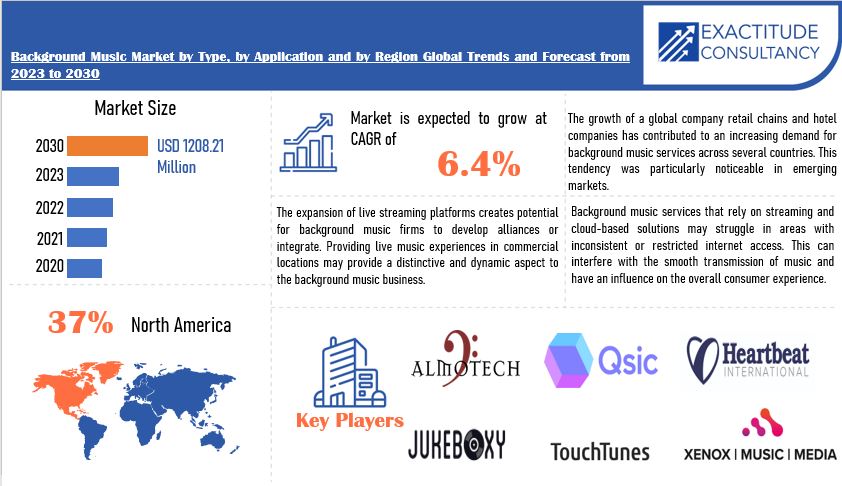
L’industrie de la musique de fond est importante car elle joue un rôle important dans l’amélioration de nombreux types de médias, de divertissement et d’environnements commerciaux. Les entreprises de tous les secteurs reconnaissent l’importance de la musique de fond en termes d’expérience client, d’identification de la marque et d’ambiance générale. Dans les environnements de vente au détail, une musique de fond appropriée peut influencer le comportement des consommateurs, encourager des visites plus longues et favoriser une ambiance favorable qui conduit à des ventes plus importantes. Les créateurs de films, de télévision et de jeux vidéo utilisent la musique de fond pour susciter des émotions, améliorer le scénario et connecter les gens à un niveau plus profond. L’ industrie de la musique de fond est particulièrement importante pour les fournisseurs de contenu, les annonceurs et les organisateurs d’événements car elle leur permet de renforcer les messages et de créer des moments mémorables. À mesure que la technologie progresse, le besoin de solutions de musique de fond personnalisées et organisées augmente, ce qui rend l’industrie dynamique et sensible aux goûts changeants des clients. Enfin, l’industrie de la musique de fond joue un rôle important dans l’établissement du paysage sensoriel de divers lieux et médias, influençant la façon dont les gens perçoivent et interagissent avec les informations ou les situations qui les entourent.
| ATTRIBUT | DETAILS |
| Study period | 2020-2030 |
| Base year | 2022 |
| Estimated year | 2023 |
| Forecasted year | 2023-2030 |
| Historical period | 2019-2021 |
| Unit | Value (USD Million) |
| Segmentation | By Type, Application and Region |
| By Type |
|
| By Application |
|
| By Region |
|
Frequently Asked Questions
• What is the market size for the Background Music Market?
The global background music market size is projected to grow from USD 782.62 million in 2023 to USD 1208.21 million by 2030, exhibiting a CAGR of 6.4% during the forecast period.
• Which region is dominating in the Background Music Market?
North America accounted for the largest market in the background music market.
• Who are the major key players in the Background Music Market?
Almotech, Auracle Sound, BrandTrack, Cloud Cover Music, CSI Music Service, Express Melody, Heartbeats International, Imagesound, Jukeboxy, Mood Media Corporation., NSM Music Ltd.,PlayNetwork, Qsic Pty Ltd., Sirius XM Holdings, Sound Machine, Store Play, Sunflower Music Company, Touch Tunes, USEN Holding Corporation Inc., Xenox Music Media.
• What are the key trends in the Background Music Market?
Subscription-based background music services were becoming increasingly popular. Businesses valued the cost-effectiveness and convenience of subscribing to a service that supplied a steady and diverse stream of music.
Background Music Market Segmentation Analysis
The global background music market is bifurcated three segments, by type, application and region. By type, the market is bifurcated into music streaming, AV system equipment. By application, the market is bifurcated retail stores, restaurants, entertainment places, public organizations, and others and region.
[caption id="attachment_36557" align="aligncenter" width="593"]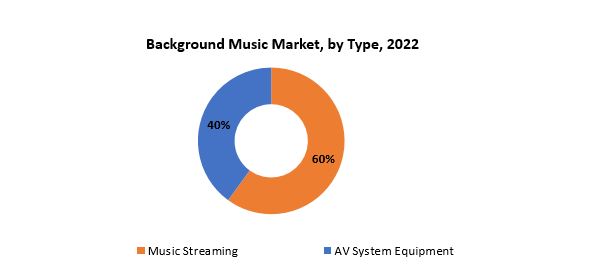
The background music market is divided into two types: music streaming and AV system equipment, demonstrating the wide range of technical solutions that meet the demands of various industries. Music streaming has grown in popularity as a handy and adaptable alternative for businesses, allowing them to access a large collection of music and create playlists tailored to their brand or mood. This sort of background music distribution is flexible and easy to customize, allowing businesses to dynamically alter their audio environment. In contrast, AV system equipment includes hardware and technological infrastructure for audio-visual configurations such as speakers, amplifiers, and control systems. This category is essential for venues with more sophisticated audio needs, such as theaters, concert halls, or big event spaces, where a reliable and integrated AV system is required to offer high-quality sound. The division into music streaming and AV system equipment reflects the industry's acknowledgment of varying tastes and requirements across enterprises, providing a range of solutions to fulfill the diversified demands of clients in various industries. The background music market's dynamic character is aided by the ongoing progress of technology in each of these categories.
[caption id="attachment_36558" align="aligncenter" width="626"]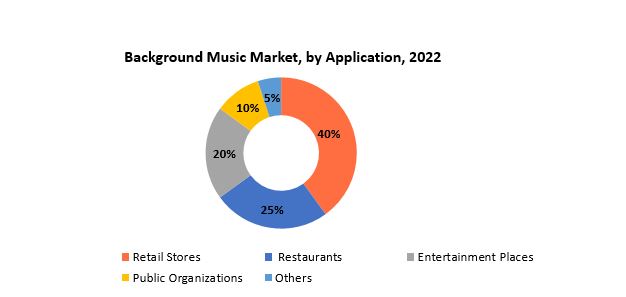
The background music industry is divided into numerous sectors based on application, with each representing a unique setting in which music plays an important part in molding the entire experience. Retailers use background music to create a pleasant retail environment, influence consumer behavior, and promote brand identification. The choice of background music in restaurants helps to the eating environment, which improves the entire customer experience. Background music is used in entertainment venues including theaters, clubs, and amusement parks to set the mood, build enthusiasm, and compliment the entertainment offers. Background music is used in public places such as workplaces, airports, and government buildings to create a positive work or service environment. The "others" category includes a wide range of applications, such as healthcare facilities, hotels, and educational institutions, where background music is employed for everything from relaxing in waiting rooms to establishing a focused learning atmosphere. The market's application segmentation reflects the unique demands and preferences across sectors, highlighting background music's adaptability in enhancing the environment and achieving specific goals in a variety of contexts. This personalized approach guarantees that businesses and organizations may select solutions that meet their specific needs and goals.
[caption id="attachment_36559" align="aligncenter" width="608"]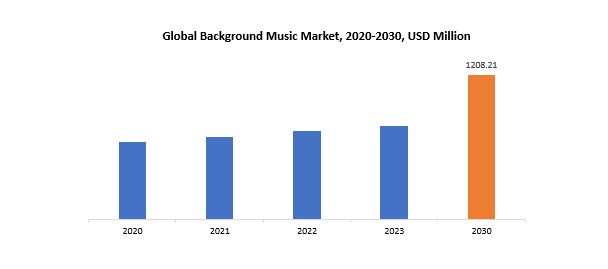
Background Music Market Dynamics
DriverThe increasing demand for background music in retail and hospitality sectors stems from its recognized role in enhancing the overall customer experience.
Background music is used strategically in retail establishments, restaurants, hotels, and other hospitality venues, going beyond simply aural accompaniment. It has become an essential aspect of the ambiance, contributing to a sensory environment that matches the company identity and appeals to the target demographic. In retail, for example, professionally designed playlists may affect consumer behavior by influencing things like dwell duration and purchase decisions. Retailers recognize that the correct background music can create a positive and immersive environment, building a bond between customers and brands. This, in turn, can boost client satisfaction and loyalty. Similarly, in the hospitality business, background music is important in determining the mood of restaurants, hotels, and other entertainment venues. It adds to the ambiance of the restaurant, affecting how people perceive their whole eating or leisure experience. The music selection may be tailored to the target demographics’ interests, producing a friendly and entertaining environment that encourages patrons to spend more time and, as a result, money.
Restraint Securing music rights for commercial use may be difficult and expensive.The licensing and copyright issues involved with the use of background music in commercial contexts provide a substantial barrier for enterprises, particularly small businesses with limited resources. Obtaining the proper permits for music consumption entails negotiating a complicated and sometimes confusing legal landscape. This intricacy stems from the requirement to get licenses from a variety of groups, including record companies, artists, and performance rights organizations, each with their own set of musical rights. Obtaining these permits can be costly for small enterprises with limited funds. The procedure include negotiating and entering into agreements with rights holders, with costs varying according on the type of company, audience size, and frequency of music consumption. As a result, the financial burden of meeting licensing requirements can be especially difficult for smaller businesses that may lack the financial flexibility to devote considerable resources to this area of their operations. Furthermore, the variability in regulatory compliance among areas and nations adds another degree of complication. Businesses operating in several jurisdictions must negotiate and comply with various copyright laws and licensing systems, which adds to the administrative and legal obstacles. This may be especially difficult for firms looking to grow worldwide or those with many sites exposed to various regulatory frameworks. Compliance with copyright restrictions is not only a legal requirement, but also an important component of ethical business operations. Noncompliance can result in legal implications such as fines and legal actions, thereby harming a company's reputation.
OpportunitiesThe integration of AI and ML technologies presents an opportunity for more personalized and adaptive background music experiences.
The integration of Artificial Intelligence (AI) and Machine Learning (ML) technology in the background music sector promises a game-changing possibility to provide highly tailored and adaptable client experiences. Businesses may use AI and ML algorithms to monitor user behavior, preferences, and contextual elements in real time, allowing for dynamic playlist updates and dramatically improving the entire customer experience. AI-powered background music systems can use data analytics to determine individual and group preferences. By recording client interactions and replies, these systems may adjust and build playlists that reflect the audience's distinct likes and moods. Machine Learning algorithms are essential for forecasting client preferences using historical data and real-time inputs. As clients engage with the surroundings, the system continually learns from their responses and modifies the music selection appropriately. This adaptive learning process enables a degree of personalization that goes beyond standard static playlists, resulting in a more interesting and individualized experience for each user.
Background Music Market Trends
-
Companies were increasingly looking for customized and adaptable background music options. The ability to customize music playlists to reflect certain company identities or adjust to changing times of day was becoming increasingly popular.
-
Artificial intelligence and machine learning were increasingly being integrated into background music services. These technologies were utilized to assess client preferences and habits, allowing businesses to create more relevant and interesting playlists.
-
Music streaming services were becoming increasingly popular for use as background music in commercial situations. Streaming systems provided a wide collection of music, simple access, and the ability to modify playlists in real time.
-
Businesses across sectors were focusing more on the influence of background music on the customer experience. Whether in retail, hospitality, or entertainment, establishing the correct environment through music was seen as an important aspect in attracting and maintaining consumers.
-
Advances in audiovisual technology were having an impact on the market. This includes upgrades to sound equipment, spatial audio, and integration with other technologies to improve the entire audio-visual experience.
-
Businesses were becoming increasingly conscious of the importance of adhering to licensing requirements while utilizing background music in business situations. This understanding fueled the use of legal and licensed music services.
Competitive Landscape
The competitive landscape of the background music market was dynamic, with several prominent companies competing to provide innovative and advanced background music.
- Almotech
- Auracle Sound
- BrandTrack
- Cloud Cover Music
- CSI Music Service
- Express Melody
- Heartbeats International
- Imagesound
- Jukeboxy
- Mood Media Corporation.
- NSM Music Ltd.
- PlayNetwork
- Qsic Pty Ltd.
- Sirius XM Holdings
- SoundMachine
- StorePlay
- Sunflower Music Company
- Touch Tunes
- USEN Holding Corporation Inc.
- Xenox Music Media
December 25, 2023 — Harmonizing Musical Taste and Identity: Unleashing the Power of Personalized Playlists- Juke boxy! In our universe, music is not just a series of notes and harmonies; it is the breath of vibrancy, the craft of enjoyable moments, and a canvas painted with the colours of diverse identities. Here, every tune tells a story, and every beat pulsates with the joyful energy of life and connection. Harmonizing musical taste and identity: unleashing the power of personalized playlists.
January 11, 2024 – SiriusXM announced today that global superstar Maluma would kick off football’s biggest weekend with an exclusive concert for SiriusXM and Pandora on Thursday, February 8 at The Theatre at Virgin Hotels Las Vegas.
Regional Analysis
North America will have the biggest market share over the projection period. The North American region's rise can be linked to the increased use of background music across numerous end-use sectors in the United States. Furthermore, the Background Music Market in North America is bolstered by an expanding number of music subscription services. North America has made significant contributions to the background music industry due to a robust economy, high consumer spending, and a technologically advanced civilization. The retail, hotel, and entertainment businesses in the United States and Canada make extensive use of background music services.
[caption id="attachment_36560" align="aligncenter" width="817"]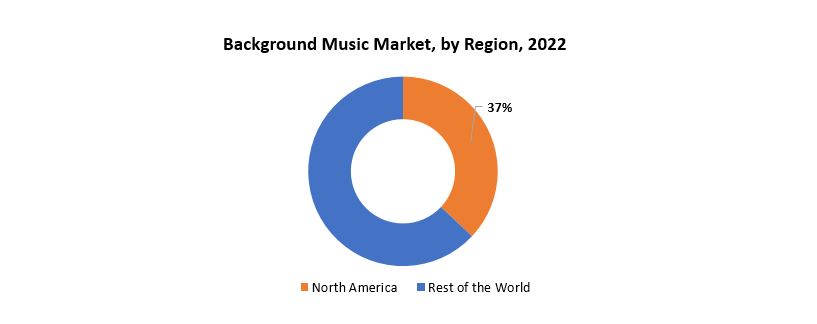
Secondly, the background music market in Asia-Pacific is rapidly expanding. Background music solutions are in high demand in countries with a strong retail culture and a booming hospitality industry, such as China, Japan, and South Korea. Rising disposable incomes, urbanization, and increased consumer spending all contribute to the region's growth. South America, the Middle East, and Africa are developing markets for background music, with companies understanding the value of providing immersive consumer experiences. These areas have a burgeoning retail sector and are investing in improving their hospitality infrastructure, which creates chances for background musicians.
Target Audience for Background Music Market
- Retail Stores
- Restaurants and Cafes
- Entertainment Venues
- Hospitality Industry
- Commercial Spaces
- Educational Institutions
- Event Organizers
- Advertising and Marketing Agencies
- Health and Wellness Facilities
- Automotive Industry
Segments Covered In the Background Music Market Report
Background Music Market by Type- Music Streaming
- AV System Equipment
- Retail Stores
- Restaurants
- Entertainment Places
- Public Organizations
- Others
- North America
- Europe
- Asia Pacific
- South America
- Middle East and Africa
Key Question Answered
- What is the expected growth rate of the Background Music Market over the next 7 years?
- Who are the key market participants Background Music, and what are their market share?
- What are the end-user industries driving market demand and what is their outlook?
- What are the opportunities for growth in emerging markets such as Asia-Pacific, the Middle East, and Africa?
- How is the economic environment affecting the Background Music Market, including factors such as interest rates, inflation, and exchange rates?
- What is the expected impact of government policies and regulations on the Background Music Market?
- What is the current and forecasted size and growth rate of the global Background Music Market?
- What are the key drivers of growth in the Background Music Market?
- Who are the major players in the market and what is their market share?
- What are the distribution channels and supply chain dynamics in the Background Music Market?
- What are the technological advancements and innovations in the Background Music Market and their impact on product development and growth?
- What are the regulatory considerations and their impact on the market?
- What are the challenges faced by players in the Background Music Market and how are they addressing these challenges?
- What are the opportunities for growth and expansion in the Background Music Market?
- What are the product offerings and specifications of leading players in the market?
- INTRODUCTION
- MARKET DEFINITION
- MARKET SEGMENTATION
- RESEARCH TIMELINES
- ASSUMPTIONS AND LIMITATIONS
- RESEARCH METHODOLOGY
- DATA MINING
- SECONDARY RESEARCH
- PRIMARY RESEARCH
- SUBJECT-MATTER EXPERTS’ ADVICE
- QUALITY CHECKS
- FINAL REVIEW
- DATA TRIANGULATION
- BOTTOM-UP APPROACH
- TOP-DOWN APPROACH
- RESEARCH FLOW
- DATA SOURCES
- DATA MINING
- EXECUTIVE SUMMARY
- MARKET OVERVIEW
- BACKGROUND MUSIC MARKET OUTLOOK
- MARKET DRIVERS
- MARKET RESTRAINTS
- MARKET OPPORTUNITIES
- IMPACT OF COVID-19 ON BACKGROUND MUSIC MARKET
- PORTER’S FIVE FORCES MODEL
- THREAT FROM NEW ENTRANTS
- THREAT FROM SUBSTITUTES
- BARGAINING POWER OF SUPPLIERS
- BARGAINING POWER OF CUSTOMERS
- DEGREE OF COMPETITION
- INDUSTRY VALUE CHAIN ANALYSIS
- BACKGROUND MUSIC MARKET OUTLOOK
- GLOBAL BACKGROUND MUSIC MARKET BY TYPE, 2020-2030, (USD MILLION)
- MUSIC STREAMING
- AV SYSTEM EQUIPMENT
- GLOBAL BACKGROUND MUSIC MARKET BY APPLICATION, 2020-2030, (USD MILLION)
- RETAIL STORES
- RESTAURANTS
- ENTERTAINMENT PLACES
- PUBLIC ORGANIZATIONS
- OTHERS
- GLOBAL BACKGROUND MUSIC MARKET BY REGION, 2020-2030, (USD MILLION)
- NORTH AMERICA
- US
- CANADA
- MEXICO
- SOUTH AMERICA
- BRAZIL
- ARGENTINA
- COLOMBIA
- REST OF SOUTH AMERICA
- EUROPE
- GERMANY
- UK
- FRANCE
- ITALY
- SPAIN
- RUSSIA
- REST OF EUROPE
- ASIA PACIFIC
- INDIA
- CHINA
- JAPAN
- SOUTH KOREA
- AUSTRALIA
- SOUTH-EAST ASIA
- REST OF ASIA PACIFIC
- MIDDLE EAST AND AFRICA
- UAE
- SAUDI ARABIA
- SOUTH AFRICA
- REST OF MIDDLE EAST AND AFRICA
- NORTH AMERICA
- COMPANY PROFILES*
(BUSINESS OVERVIEW, COMPANY SNAPSHOT, PRODUCTS OFFERED, RECENT DEVELOPMENTS)
- ALMOTECH
- AURACLE SOUND
- BRANDTRACK
- CLOUD COVER MUSIC
- CSI MUSIC SERVICE
- EXPRESS MELODY
- HEARTBEATS INTERNATIONAL
- IMAGESOUND
- JUKEBOXY
- MOOD MEDIA CORPORATION.
- NSM MUSIC LTD.
- PLAYNETWORK
- QSIC PTY LTD.
- SIRIUS XM HOLDINGS
- SOUNDMACHINE
- STOREPLAY
- SUNFLOWER MUSIC COMPANY
- TOUCH TUNES
- USEN HOLDING CORPORATION INC.
- XENOX MUSIC MEDIA
*THE COMPANY LIST IS INDICATIVE
LIST OF TABLES
TABLE 1 GLOBAL BACKGROUND MUSIC MARKET BY TYPE (USD MILLION) 2020-2030
TABLE 2 GLOBAL BACKGROUND MUSIC MARKET BY APPLICATION (USD MILLION) 2020-2030
TABLE 3 GLOBAL BACKGROUND MUSIC MARKET BY REGION (USD MILLION) 2020-2030
TABLE 4 NORTH AMERICA BACKGROUND MUSIC MARKET BY COUNTRY (USD MILLION) 2020-2030
TABLE 5 NORTH AMERICA BACKGROUND MUSIC MARKET BY TYPE (USD MILLION) 2020-2030
TABLE 6 NORTH AMERICA BACKGROUND MUSIC MARKET BY APPLICATION (USD MILLION) 2020-2030
TABLE 7 US BACKGROUND MUSIC MARKET BY TYPE (USD MILLION) 2020-2030
TABLE 8 US BACKGROUND MUSIC MARKET BY APPLICATION (USD MILLION) 2020-2030
TABLE 9 CANADA BACKGROUND MUSIC MARKET BY TYPE (USD MILLION) 2020-2030
TABLE 10 CANADA BACKGROUND MUSIC MARKET BY APPLICATION (USD MILLION) 2020-2030
TABLE 11 MEXICO BACKGROUND MUSIC MARKET BY TYPE (USD MILLION) 2020-2030
TABLE 12 MEXICO BACKGROUND MUSIC MARKET BY APPLICATION (USD MILLION) 2020-2030
TABLE 13 SOUTH AMERICA BACKGROUND MUSIC MARKET BY COUNTRY (USD MILLION) 2020-2030
TABLE 14 SOUTH AMERICA BACKGROUND MUSIC MARKET BY TYPE (USD MILLION) 2020-2030
TABLE 15 SOUTH AMERICA BACKGROUND MUSIC MARKET BY APPLICATION (USD MILLION) 2020-2030
TABLE 16 BRAZIL BACKGROUND MUSIC MARKET BY TYPE (USD MILLION) 2020-2030
TABLE 17 BRAZIL BACKGROUND MUSIC MARKET BY APPLICATION (USD MILLION) 2020-2030
TABLE 18 ARGENTINA BACKGROUND MUSIC MARKET BY TYPE (USD MILLION) 2020-2030
TABLE 19 ARGENTINA BACKGROUND MUSIC MARKET BY APPLICATION (USD MILLION) 2020-2030
TABLE 20 COLOMBIA BACKGROUND MUSIC MARKET BY TYPE (USD MILLION) 2020-2030
TABLE 21 COLOMBIA BACKGROUND MUSIC MARKET BY APPLICATION (USD MILLION) 2020-2030
TABLE 22 REST OF SOUTH AMERICA BACKGROUND MUSIC MARKET BY TYPE (USD MILLION) 2020-2030
TABLE 23 REST OF SOUTH AMERICA BACKGROUND MUSIC MARKET BY APPLICATION (USD MILLION) 2020-2030
TABLE 24 ASIA-PACIFIC BACKGROUND MUSIC MARKET BY COUNTRY (USD MILLION) 2020-2030
TABLE 25 ASIA-PACIFIC BACKGROUND MUSIC MARKET BY TYPE (USD MILLION) 2020-2030
TABLE 26 ASIA-PACIFIC BACKGROUND MUSIC MARKET BY APPLICATION (USD MILLION) 2020-2030
TABLE 27 INDIA BACKGROUND MUSIC MARKET BY TYPE (USD MILLION) 2020-2030
TABLE 28 INDIA BACKGROUND MUSIC MARKET BY APPLICATION (USD MILLION) 2020-2030
TABLE 29 CHINA BACKGROUND MUSIC MARKET BY TYPE (USD MILLION) 2020-2030
TABLE 30 CHINA BACKGROUND MUSIC MARKET BY APPLICATION (USD MILLION) 2020-2030
TABLE 31 JAPAN BACKGROUND MUSIC MARKET BY TYPE (USD MILLION) 2020-2030
TABLE 32 JAPAN BACKGROUND MUSIC MARKET BY APPLICATION (USD MILLION) 2020-2030
TABLE 33 SOUTH KOREA BACKGROUND MUSIC MARKET BY TYPE (USD MILLION) 2020-2030
TABLE 34 SOUTH KOREA BACKGROUND MUSIC MARKET BY APPLICATION (USD MILLION) 2020-2030
TABLE 35 AUSTRALIA BACKGROUND MUSIC MARKET BY TYPE (USD MILLION) 2020-2030
TABLE 36 AUSTRALIA BACKGROUND MUSIC MARKET BY APPLICATION (USD MILLION) 2020-2030
TABLE 37 SOUTH-EAST ASIA BACKGROUND MUSIC MARKET BY TYPE (USD MILLION) 2020-2030
TABLE 38 SOUTH-EAST ASIA BACKGROUND MUSIC MARKET BY APPLICATION (USD MILLION) 2020-2030
TABLE 39 REST OF ASIA PACIFIC BACKGROUND MUSIC MARKET BY TYPE (USD MILLION) 2020-2030
TABLE 40 REST OF ASIA PACIFIC BACKGROUND MUSIC MARKET BY APPLICATION (USD MILLION) 2020-2030
TABLE 41 EUROPE BACKGROUND MUSIC MARKET BY COUNTRY (USD MILLION) 2020-2030
TABLE 42 EUROPE BACKGROUND MUSIC MARKET BY TYPE (USD MILLION) 2020-2030
TABLE 43 EUROPE BACKGROUND MUSIC MARKET BY APPLICATION (USD MILLION) 2020-2030
TABLE 44 GERMANY BACKGROUND MUSIC MARKET BY TYPE (USD MILLION) 2020-2030
TABLE 45 GERMANY BACKGROUND MUSIC MARKET BY APPLICATION (USD MILLION) 2020-2030
TABLE 46 UK BACKGROUND MUSIC MARKET BY TYPE (USD MILLION) 2020-2030
TABLE 47 UK BACKGROUND MUSIC MARKET BY APPLICATION (USD MILLION) 2020-2030
TABLE 48 FRANCE BACKGROUND MUSIC MARKET BY TYPE (USD MILLION) 2020-2030
TABLE 49 FRANCE BACKGROUND MUSIC MARKET BY APPLICATION (USD MILLION) 2020-2030
TABLE 50 ITALY BACKGROUND MUSIC MARKET BY TYPE (USD MILLION) 2020-2030
TABLE 51 ITALY BACKGROUND MUSIC MARKET BY APPLICATION (USD MILLION) 2020-2030
TABLE 52 SPAIN BACKGROUND MUSIC MARKET BY TYPE (USD MILLION) 2020-2030
TABLE 53 SPAIN BACKGROUND MUSIC MARKET BY APPLICATION (USD MILLION) 2020-2030
TABLE 54 RUSSIA BACKGROUND MUSIC MARKET BY TYPE (USD MILLION) 2020-2030
TABLE 55 RUSSIA BACKGROUND MUSIC MARKET BY APPLICATION (USD MILLION) 2020-2030
TABLE 56 REST OF EUROPE BACKGROUND MUSIC MARKET BY TYPE (USD MILLION) 2020-2030
TABLE 57 REST OF EUROPE BACKGROUND MUSIC MARKET BY APPLICATION (USD MILLION) 2020-2030
TABLE 58 MIDDLE EAST AND AFRICA BACKGROUND MUSIC MARKET BY COUNTRY (USD MILLION) 2020-2030
TABLE 59 MIDDLE EAST AND AFRICA BACKGROUND MUSIC MARKET BY TYPE (USD MILLION) 2020-2030
TABLE 60 MIDDLE EAST AND AFRICA BACKGROUND MUSIC MARKET BY APPLICATION (USD MILLION) 2020-2030
TABLE 61 UAE BACKGROUND MUSIC MARKET BY TYPE (USD MILLION) 2020-2030
TABLE 62 UAE BACKGROUND MUSIC MARKET BY APPLICATION (USD MILLION) 2020-2030
TABLE 63 SAUDI ARABIA BACKGROUND MUSIC MARKET BY TYPE (USD MILLION) 2020-2030
TABLE 64 SAUDI ARABIA BACKGROUND MUSIC MARKET BY APPLICATION (USD MILLION) 2020-2030
TABLE 65 SOUTH AFRICA BACKGROUND MUSIC MARKET BY TYPE (USD MILLION) 2020-2030
TABLE 66 SOUTH AFRICA BACKGROUND MUSIC MARKET BY APPLICATION (USD MILLION) 2020-2030
TABLE 67 REST OF MIDDLE EAST AND AFRICA BACKGROUND MUSIC MARKET BY TYPE (USD MILLION) 2020-2030
TABLE 68 REST OF MIDDLE EAST AND AFRICA BACKGROUND MUSIC MARKET BY APPLICATION (USD MILLION) 2020-2030
LIST OF FIGURES
FIGURE 1 MARKET DYNAMICS
FIGURE 2 MARKET SEGMENTATION
FIGURE 3 REPORT TIMELINES: YEARS CONSIDERED
FIGURE 4 DATA TRIANGULATION
FIGURE 5 BOTTOM-UP APPROACH
FIGURE 6 TOP-DOWN APPROACH
FIGURE 7 RESEARCH FLOW
FIGURE 8 GLOBAL BACKGROUND MUSIC MARKET BY TYPE, USD MILLION, 2022-2030
FIGURE 9 GLOBAL BACKGROUND MUSIC MARKET BY APPLICATION, USD MILLION, 2022-2030
FIGURE 10 GLOBAL BACKGROUND MUSIC MARKET BY REGION, USD MILLION, 2022-2030
FIGURE 11 PORTER’S FIVE FORCES MODEL
FIGURE 12 GLOBAL BACKGROUND MUSIC MARKET BY TYPE, USD MILLION,2022
FIGURE 13 GLOBAL BACKGROUND MUSIC MARKET BY APPLICATION, USD MILLION,2022
FIGURE 14 GLOBAL BACKGROUND MUSIC MARKET BY REGION, USD MILLION,2022
FIGURE 15 MARKET SHARE ANALYSIS
FIGURE 16 ALMOTECH: COMPANY SNAPSHOT
FIGURE 17 AURACLE SOUND: COMPANY SNAPSHOT
FIGURE 18 BRANDTRACK: COMPANY SNAPSHOT
FIGURE 19 CLOUD COVER MUSIC: COMPANY SNAPSHOT
FIGURE 20 CSI MUSIC SERVICE: COMPANY SNAPSHOT
FIGURE 21 EXPRESS MELODY: COMPANY SNAPSHOT
FIGURE 22 HEARTBEATS INTERNATIONAL: COMPANY SNAPSHOT
FIGURE 23 IMAGESOUND: COMPANY SNAPSHOT
FIGURE 24 JUKEBOXY: COMPANY SNAPSHOT
FIGURE 25 MOOD MEDIA CORPORATION: COMPANY SNAPSHOT
FIGURE 26 NSM MUSIC LTD.: COMPANY SNAPSHOT
FIGURE 27 PLAYNETWORK: COMPANY SNAPSHOT
FIGURE 28 QSIC PTY LTD.: COMPANY SNAPSHOT
FIGURE 29 SIRIUS XM HOLDINGS: COMPANY SNAPSHOT
FIGURE 30 SOUNDMACHINE: COMPANY SNAPSHOT
FIGURE 31 STOREPLAY: COMPANY SNAPSHOT
FIGURE 32 SUNFLOWER MUSIC COMPANY: COMPANY SNAPSHOT
FIGURE 33 TOUCH TUNES: COMPANY SNAPSHOT
FIGURE 34 USEN HOLDING CORPORATION INC.: COMPANY SNAPSHOT
FIGURE 35 XENOX MUSIC MEDIA: COMPANY SNAPSHOT
DOWNLOAD FREE SAMPLE REPORT
License Type
SPEAK WITH OUR ANALYST
Want to know more about the report or any specific requirement?
WANT TO CUSTOMIZE THE REPORT?
Our Clients Speak
We asked them to research ‘ Equipment market’ all over the world, and their whole arrangement was helpful to us. thehealthanalytics.com insightful analysis and reports contributed to our current analysis and in creating a future strategy. Besides, the te
Yosuke Mitsui
Senior Associate Construction Equipment Sales & Marketing
We asked them to research ‘Equipment market’ all over the world, and their whole arrangement was helpful to us. thehealthanalytics.com insightful analysis and reports contributed to our current analysis and in creating a future strategy. Besides, the te






